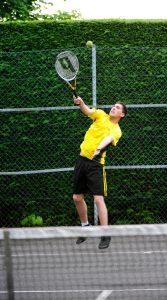We may earn money or products from the companies mentioned in this post.
Introduction

Tennis is a dynamic and exhilarating sport that requires skill, technique, and precision The game is played with a variety of shots that players use strategically to outmaneuver their opponents Understanding the different types of tennis shots is crucial for any aspiring player or avid fan
1 Groundstrokes
Groundstrokes are the foundation of any tennis player’s arsenal These shots are executed from the baseline and involve hitting the ball after its first bounce The two primary groundstrokes in tennis are forehand and backhand The forehand is typically executed with a player’s dominant hand, while the backhand can be performed using either one or both hands on the racket grip
2 Volleys
Volleys are shots that are played near the net, usually in response to an opponent’s shot Unlike groundstrokes, volleys are hit before the ball bounces on the court surface Players often use quick reflexes and soft touches to execute precise volleys, aiming to place the ball strategically within their opponent’s reach or out of it altogether
3 Serves
The serve is arguably one of the most crucial shots in tennis as it initiates each point of play This shot involves hitting the ball into play from behind the baseline towards an opponent’s service box diagonally across from them Serves require power, accuracy, and spin to make them difficult for opponents to return effectively
4 Overhead Smashes
The overhead smash, also known as a smash or overhead volley, is a powerful offensive shot played when an opponent hits a high lobbed shot over your head towards your side of the court near the net As its name suggests, this shot involves smashing the ball downwards with force and precision to prevent opponents from effectively returning it
Introducing the High Tennis Shot

Now, let’s dive into a specific tennis shot that requires skill, timing, and a keen sense of anticipation We’re talking about the high tennis shot – a challenging yet thrilling maneuver that can change the momentum of a match in an instant
The Lob: A High Tennis Shot Explored

Have you ever witnessed a skilled tennis player gracefully sending the ball soaring high above the net? This shot, known as the lob, is not only visually captivating but also serves a crucial purpose in the game In this article, we will delve into the definition and purpose of a lob, exploring its defensive and offensive capabilities
Defensive Lobs: Buying Time and Regaining Position
Defensive lobs are a tactical maneuver used by players to buy themselves precious time on the court When faced with an opponent who has gained an advantageous position near the net, executing a well-placed lob can disrupt their momentum and force them to retreat
By expertly lofting the ball over their opponent’s head, players can regain control of the match This momentary respite allows them to reposition themselves strategically on the court, ensuring they are ready for whatever comes next
Offensive Lobs: Catching Opponents Off-Guard and Targeting Weak Overheads
The offensive lob is a weapon in a player’s arsenal that can catch opponents off-guard With impeccable timing and precision, players launch high-arcing shots that sail just beyond their opponents’ reach This unexpected move forces opponents to quickly adjust their positioning and scramble back towards the baseline
In addition to disrupting opponents’ rhythm, offensive lobs can also exploit weaknesses in their overhead shots By targeting opponents who struggle with high balls or lack confidence in their overhead technique, players can gain a significant advantage during crucial points in the match
In summary, lobs are not just visually impressive shots; they serve important roles both defensively and offensively Whether it’s buying time and regaining position or catching opponents off-guard and exploiting weaknesses – the lob is a versatile tool in a tennis player’s repertoire So, the next time you witness a perfectly executed lob, take a moment to appreciate its strategic significance and the skill required to execute it
Techniques for Executing Lobs Effectively

When it comes to executing lobs effectively in tennis, there are two main techniques that players can employ: the backspin lob and the topspin lob These techniques require specific grips, swing paths, and follow-throughs to achieve optimal results
Backspin Lob Technique
-
Proper grip on racket:
To execute a backspin lob, it’s important to have a firm grip on the racket This allows for better control and maneuverability during the shot -
Open racket face angle:
By opening the racket face angle slightly, you create more spin on the ball This helps to generate backspin, allowing the ball to clear the net comfortably -
Swing path and follow-through:
The swing path for a backspin lob should be upward and slightly across the body Follow through with your swing high above your shoulder to maximize height and accuracy
Topspin Lob Technique
-
Western or semi-western grip on racket:
For a topspin lob, a western or semi-western grip is ideal as it allows for more wrist flexibility during the stroke -
Accelerated low-to-high swing:
To generate topspin and height on your lob shot, start with a low-to-high swing motion Accelerate through contact with the ball to add spin and lift -
Generating topspin and height:
The key to an effective topspin lob is generating enough topspin on the ball while also hitting it with enough height over the net Practice timing your swing and contact point to achieve the desired results
Answering Common Questions About Lobs

When to use a defensive vs offensive lob?
In tennis, knowing when to use a defensive or offensive lob can greatly impact your game Defensive lobs are typically used when you find yourself in a defensive position and need to buy time to regain control of the point On the other hand, offensive lobs are employed as a strategic shot to put pressure on your opponent by forcing them away from the net
How to practice lobbing effectively?
Practicing lob shots can greatly improve your ability to execute them effectively during matches Set up drills that focus specifically on lobs, such as hitting targets with different heights or practicing against an opponent who challenges you with overhead shots Repetition and consistency are key to refining your lobbing skills
What are the common mistakes while attempting lobs?
While attempting lobs, players often make common mistakes that hinder their success These include improper grip on the racket, incorrect swing path or follow-through, not generating enough spin or height, and lack of anticipation regarding their opponent’s positioning on the court
How can players improve their ability to read opponent’s lobs?
Improving your ability to read your opponent’s lobs is crucial in tennis Pay attention to their body positioning and racquet preparation before they hit the ball Anticipate where they might aim their lob based on their court positioning and shot selection patterns By studying these cues and gaining experience through practice, you can become more adept at reading and reacting effectively to opponent’s lobs
Useful Links

Tennis Strokes | Tennis Shots | Forehand | Backhand | Serve
Tennis Shot Types
The Different Types of Tennis Shots – A Beginner’s Guide
What is a Tennis Stroke & Which Shots Are Most Common?
What Are The 8 Basic Tennis Shots?
16 Tennis Types Of Shots Explained [With Examples]
HIGH TENNIS SHOT crossword clue – All synonyms & answers
Types of Tennis Shots You Should Master | Athlete Path
A Typology of Tennis Shots
Tennis 101: The 6 Basic Strokes Explained Step-by-Step
What are the 8 Basic Tennis Shots
The Most Complete Glossary of Tennis Terms and Slang …
Guide to Tennis Terminology and Lingo
TABLE TENNIS
Tennis Terms and Definitions | USTA
high tennis shot crossword clue
What Is A High Ball In Tennis Called?
Some Tennis Shots That Have Us Drooling
Tennis Terms You should know | A to Z






